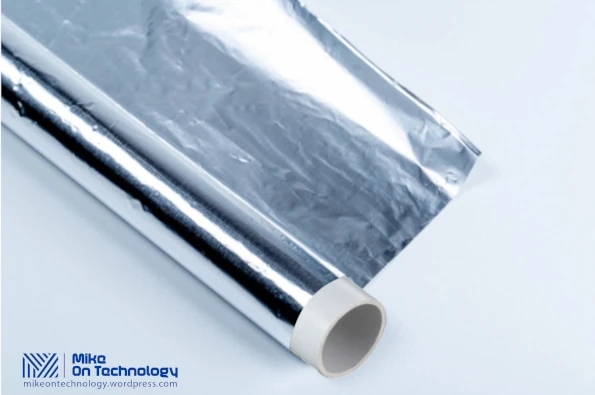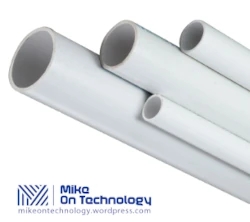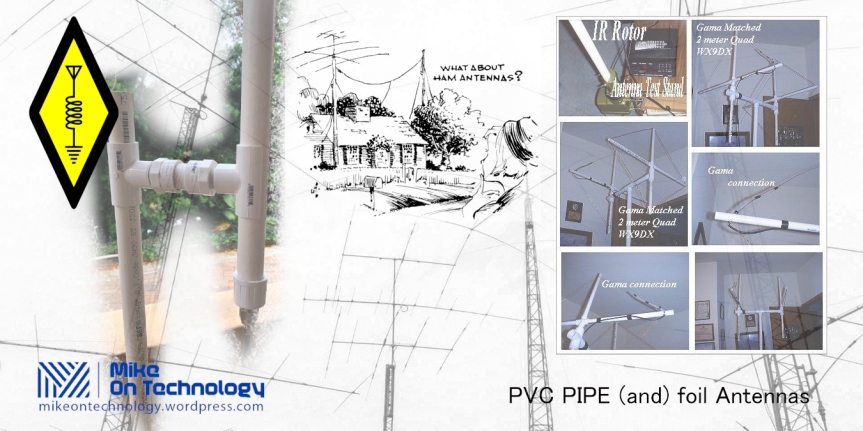PVC and foil antennas made from aluminium roof flashing tape and rigid PVC pipe save money when home building amateur radio band antennas. You could even use household aluminium cooking foil and save even more money.
We all know how the price of aluminium has shot up in recent years. This made home construction of antennas expensive. I was browsing recently through some old radio magazines and across in idea using aluminium flashing tape and PVC pipe to save money when home building aerials.
How to Build PVC and Foil Antennas
I’m not going to offer a specific antenna design in this article. Instead the article focuses on how to use these materials to build antenna elements cheaply.
To build yourself a PVC and foil antenna start off with a length of rigid PVC pipe. I suggest using either 40mm or 50mm diameter tubing. This will make an aerial with wider bandwidth than that achieved with thin diameter tubing. Sometimes a wider bandwidth is useful, especially on the VHF bands where amateur bands cover a wide frequency range.
The first thing is to calculate the electrical length of the element. NOTE: You will need to reduce the length of the conductive element a little to compensate for the increased diameter. All the formulas needed to perform these calculations are available in the ARRL Radio Amateur’s Handbook. Rather cut the pipe and foil too long as it’s easy to trim to the required lengths later.
Allow some extra length both sides of the actual electrical length, as well as a section at the bottom for a mounting point. Next measure a length of pipe and cut to the required length.
Now measure a length of flashing tape from the roll equal to the electrical element length from your calculation.
Rolling the Foil
Here I’m using normal non-adhesive cooking foil to demonstrate how the foil is applied to the PVC pipe.

This is where things can get tricky, or rather, sticky. If you have the self adhesive flashing tape with a paper backing it’s a lot easier. But if you need to use an adhesive things get sticky. Either way, the idea is to roll a layer of foil around the pipe, thereby forming a conductive surface all the way around the tubing. This forms the main element of the PVC and foil antenna.
Lots of Antenna Design Options for PVC and Foil Antennas
Using this method you can build yourself almost any antenna for these bands, although at the lower frequencies the length of the PVC pipe becomes an issue. However it’s quite feasible to build a ¼λ vertical for even the 20m band. 5/8λ verticals are possible for 10 metres and up. This method may be used to build J-pole antennas as well, however for a J-Pole cover the entire length of the PVC pole with foil, including the mounting stub. This ensures the aerial is properly DC grounded.
You could even build yagi antennas. The even cheaper PVC electrical conduit pipe will suffice for 6 metre and 2 metre yagi elements as well as shorter vertical antennas for 6m and up. Again the yagi will have a wider bandwidth as a result of the element to length ratio.
Yagi Booms and Other Antenna Support Parts
uPVC piping could also get used for making yagi booms, the part the elements are fitted to. Another use is as spreaders for delta and quad antennas. There’s probably a lot more things you could find a PVC piping useful for, let the imagination run free and see what you come up with.
Radio amateurs don’t have so many opportunities today to home build equipment. However antenna construction is an area where this is possible. Using cheap PVC and foil lets the ham experiment with various antennas without needing a large budget. Whether it’s an experimental design intended to test a more permanent, and expensive, version, or a lightweight, weather resistant more permanent antenna, using these materials lets the radio amateur get into some of the things the hobby used to be about, homebrewing our equipment.
Amateur Bands Suited to Wider Bandwidth Antennas
The radio amateur bands above 28 MHz is where a wide bandwidth antenna is most useful. This is especially the case when one only can only use a single antenna for an entire band, but wants to cover the whole band spectrum on both transmit and receive. Wider bandwidth means lower VSWR seen by the transmitter output stage.
The table below lists the details of these bands from 10m to 13 cm.
| Amateur band | Frequency range (MHz) | Bandwidth (MHz) | Ratio |
| 10m | 28 – 29.7 | 1.7 | 1:17 |
| 6m | 50 – 54 | 4 | 1:13 |
| 2m | 144 – 146 | 2 | 1:36 |
| 70cm | 430 -440 | 10 | 1:44 |
| 23cm | 1240 – 1300 | 60 | 1:21 |
| 13cm | 2300 – 2450 | 150 | 1:15 |
The wider the bandwidth the antenna needs to operate on with acceptable VSWR, the lower the ratio of bandwidth to operating frequency becomes, the lower the Q factor the antenna needs.
Antenna elements which are very thin in relation to element length give a high Q factor, hence a narrower operating bandwidth. Conversely the wider the diameter of the element in relation to its length, the lower the Q factor becomes. Therefore an antenna designed to cover a high bandwidth/frequency range should have a low Q.
There are several ways of designing a wideband antenna. The discone is a good example with a very wide bandwidth. However another way to broaden the frequency response of typical amateur radio aerials relies on a bigger diameter to physical length ratio, Simply by increasing the diameter of the antenna element we widen the antenna bandwidth. And this is where a PVC and foil antenna is useful.
uPVC Pipes
 The type of pipe to look for is uPVC which is made from ultraviolet resistant PVC. uPVC waste pipe is the most easily obtained and is cheap.
The type of pipe to look for is uPVC which is made from ultraviolet resistant PVC. uPVC waste pipe is the most easily obtained and is cheap.
uPVC waste pipe is commonly available in several diameters including 40mm, 50 mm, 63mm, and up.
The most common wall thickness available from DIY centres in South Africa is 2.8mm. However a manufacturer or larger builders merchant may offer thicker wall pipe too.
Notes on Flashing Tape.
The tape is available in a number of widths from 50 mm up. Flashing tape withstands temperature ranges from a low of -35° C to 80 ° C.


